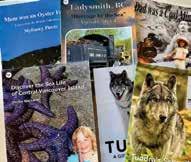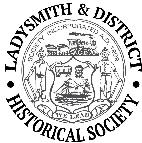










































Welcome to the Explore Guide 2025 featuring Ladysmith, Cedar, Saltair, Chemainus and area. This is the premiere guide for in print and online format for the central Vancouver Island.
Here you will find the best of what our area has to offer, information on local events, and maps so you won’t miss a thing.

We are pleased to work with our talented local photographers to capture the natural beauty of our outdoors and the charming shops and services that our friendly communities offer.
The content in these pages is geared to not only visitors to our area but our residents. This is a vast area with many places that even the locals may not know about. We encourage everyone to try something new, shake up your routine and explore the bounty of the island.
As you flip through theses pages we hope you will be inspired to explore mid Vancouver Island’s shops and services, parks and waterfront. The options are endless and often just a short drive away. So get out there and have fun!
We would like to thank the business community for their support in producing this guide, as well as the contributors who generously have shared their passion and talents and love of this community.
For more information, drop in to our local Visitor Centres.
Clockwise:

Islanders have heart. Heart-shaped leaf. Photo: Nadine Wong
A tranquil moment at Heart Lake. Photo: Tania Phiefer Great Blue Heron greets visitors. Photo: Tonya Soules.

The EXPLORE GUIDE is available in print at Visitor Centres, shops and services throughout the mid-Island area. The online edition with live links and embedded videos is available at take5.ca/explore-guide/ and everywhere in the digital universe. Visit us online for extra features, including videos, and direct links to the advertisers featured here, https://take5.ca/explore-guide/.
You can also follow us at facebook.com/ExploreLadysmithCedarSaltairChemainus, Instagram, or subscribe to YouTube.com/take5newstv for updates and news about our communities.
On the Cover:
Jessica Lowry of Align with Jessica enjoys a quiet yoga moment at Boulder Point, Saltair. Photos: Bob Burgess
Photography/Contributors: Jennifer Archer, Gerry Beltgens, Bob Burgess, Chemainus Valley Arts Cultural Society, Josee Duffhues, GNB Builders, Andrew Gunson, Carolyn Herriot, Kerri Lebrun, Nick Longo, Francesca Pacchiano, Sophie Paisley, J. Persson, Tania Phiefer, Marina Sacht, Tonya Soules, Kerith Waddington, Nadine Wong
Publisher: TAKE 5 Print & Digital Media

Editor: Marina Sacht/Asst. Editor: Francesca Pacchiano Art
Design & Maps: Angie Haslam
Sales: Susan Attiana, Nadine Wong PO Box 59, Ladysmith, BC V9G 1A1, T 250-245-7015 info@take5.ca take5.ca facebook.com/ ExploreLadysmithCedarSaltairChemainus/ youtube.com/take5newstv instagram.com/explore_mid_vancouver_island














Nestled in the foothills of rolling mountains, Ladysmith overlooks the sheltered harbour’s vibrant blue water. Known as Oyster Harbour before its incorporation in 1904, the town is famous for its spectacular natural views and historic downtown core.
First Avenue, Ladysmith’s main street, won Canada’s Greatest Street in 2017. The avenue is lined with colourful and historic buildings and beautiful trees, and in the winter, it boasts a spectacular assortment of lights. The avenue isn’t just a feast for the eyes; it’s also full of bustling boutique shops, cafés, restaurants and the Old Town Bakery — the home of the island’s best cinnamon buns.
Cedar markers in front of the heritage Agricultural Hall at the intersection of First Avenue and Symonds represent the town’s location on the 49th parallel. This is the only place west of Ontario where you can cross the parallel without a passport.
Ladysmith’s economy was built on oyster farming, mining and logging. Forestry is still part of the local economy, but the town has grown from its ideal location and business opportunities. The thriving community spirit is an aspect that draws new residents. The Festival of Lights, Ladysmith Days, Concerts in the Park, Art on the Avenue and Show ’n’ Shine are a few annual events that delight residents and tourists alike.
Ladysmith is located in the perfect place. With mild winters and warm summers, plenty of outdoor activities can be enjoyed year-
round. The warm season, from June to September, is ideal for exploring the shady trails of Holland Creek or swimming in the sparkling ocean water at Transfer Beach. The temperature drops in the winter months, with December being the coldest at a daily low of around 0 °C. Still, it’s the perfect temperature to bundle up and enjoy a hot chocolate under the hundreds of twinkling lights.
The first inhabitants here were the Stz’uminus First Nation. For thousands of years, the Stz’uminus People stewarded the land and used the harbour as a rich source of fish and shellfish. Their practices respectfully utilized the natural world to make clothing, food, houses and medicine. They carved canoes for travel, and beautiful pieces of art, and were also known for their weaving. Their lifestyle was severely disrupted when the European colonists arrived.
Ladysmith is the only community on Vancouver Island designed as a “company” town by its founder, industrialist James Dunsmuir. In 1897, when the coal mines’ seams in Nanaimo were depleted, Dunsmuir relocated the miners and their families to work in his new

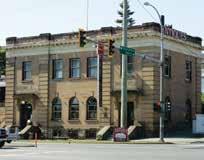





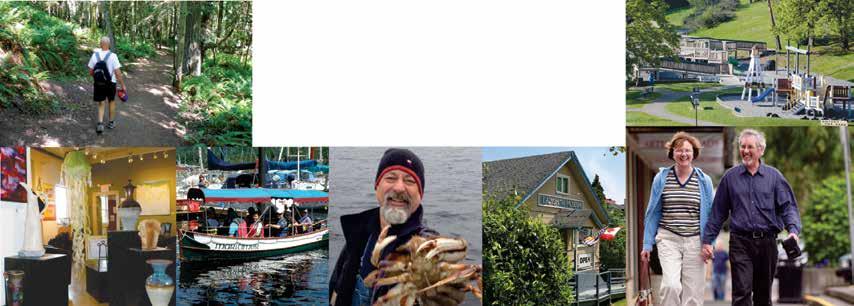
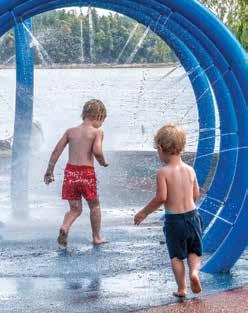
source of coal at Extension Mine. The Wellington miners dismantled their homes, put them on railway cars and moved them to Ladysmith. Included in the move were some of the hotels, churches and business blocks you can still see today.
The Ladysmith Visitor Centre offers a self-guided tour of the Historic Buildings map. You can pick up a copy in person or download the free Ladysmith Heritage and Investment Attraction App.
Ladysmith was an essential location in the early labour movement. A walk through the Ladysmith Cemetery will unfold the tragedies of lost lives in mining accidents. A monument is erected there for labour martyr Joseph Mairs.
The Vancouver Island Coal Strike began in September 1912. Violent riots broke out in August 1913, and the militia was called. The strike would not



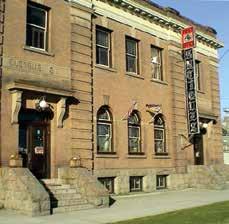






end until the start of the First World War.
In the 1930s, with coal on the decline, Ladysmith struggled economically until a violent windstorm blew over 7,406 acres of mature timber held in the trust of the Rockefeller Foundation of New York. Western Canada Lumber, the parent company of Comox Logging & Rail Co., purchased the timber from Rockefeller in 1935. This would start a long relationship with the forestry industry in Ladysmith.
Today, you can visit the former Comox Logging Site by the waterfront and still see artifacts from the town’s industrial and maritime heritage.
Whether new or established, Ladysmith is home to a variety of independent businesses. Quality consignment stores offer locally made items at a bargan price, and thrift stores and the refillery allow shoppers a guilt-free shopping experience.
Post Office Antiques, is an iconic stop in our little town. It’s a former customs and jailhouse now turned treasure trove for die-hard antique collectors and weekend wanderers alike.
A trip along First Avenue would not be complete without a stop at
the bakery for their famous cinnamon buns or a visit to the butcher for local meats and fish. Restaurants offer a world-wide cuisine selection from British, Chinese, Mexican, Indian and Japanese food to vegan, and gluten-free options. There’s something for every taste or thirst.
Transfer Beach Park is where the locals go for fun. This seaside park has something for everyone. With grassy slopes, shady trees, and a sheltered coastline, it’s the perfect spot for a family picnic. The park is wheelchair accessible and has picnic benches and washrooms. It also has a seasonal spray park and a playground.
The ocean is inviting, with the warmest waters north of San Francisco. At 17.90 degrees Celsius (64.22 F), the average monthly water temperature reaches its highest value in July, but the Transfer Beach Dippers swim year-round. If swimming isn’t your thing, there is a dog off-leash area, kayak rentals, a sand volleyball court and plenty more to enjoy.
In October 2024, over 400 native plants were planted in beds designed to withstand drought and support pollinators. The Bird







Shrubbery and Butterfly Meadow will attract a variety of local wildlife and are great places for visitors to learn what to grow in their own gardens.
The park is home to Vancouver Island’s only beachfront amphitheatre and is an active venue for events and summer music concerts. Enjoy a picnic at one of the many tables or visit the food trucks operating there in the summer.
Residents will tell you that one of their favourite gems is the historic Holland Creek Trail. It offers 5.8 kilometres of trail, with highlights like the Crystal Falls and the Colliery Dams. The trail is wheelchair accessible from the Methuen/6th Avenue entrance.
Ladysmith is a popular spot with filmmakers given its small-town charm. A number of movies and TV series have been filmed here, attracted by Ladysmith’s unique wide streets and brick buildings.
Pamela Anderson, the town’s most famous resident, moved back to her hometown and has been restoring her grandmother’s place, the Arcady Auto Court, as featured in her HGTV show, Pamela’s Garden of Eden.
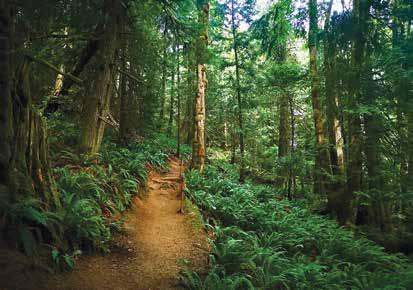





From the last Thursday of November until the second Sunday in January, Ladysmith is adorned with thousands of twinkling lights for Ladysmith’s Festival of Lights.
The festival was started in 1987 by a group of citizens as a way to celebrate the season and support local shopping. Now, years later, it has become a much-loved Christmas tradition, near and far, with thousands of people gathering to watch the fun.
The Christmas Craft Fair at Aggie Hall opens at 3 p.m., and from 4 p.m. to 6:15 p.m., locals and visitors can enjoy street entertainment, food concessions, and street performers. Anticipation runs high until the big moment when Santa arrives downtown and throws the switch to light up Ladysmith at 6:30 p.m., followed by the Kinsmen night parade.
After the parade, head north on First Avenue and see the light up of Bob Stuart Park, the Aggie Hall and the Chuck Perrin Tree. The lights may be dazzling, but it’s the community spirit that shines.
The main summer festival is Ladysmith Celebration Days, a week-
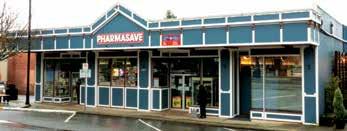

end filled with fun and music at Transfer Beach. Other notable events include Brits on the Beach, Ladysmith’s Show ’n’ Shine, Arts on the Avenue, Sunday Concerts in the Park, and Oktoberfest. There is always something happening here.
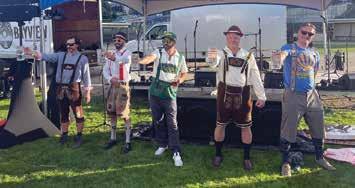

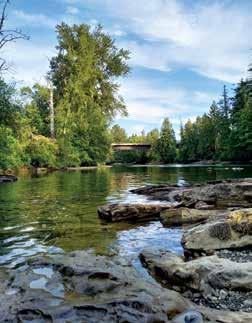

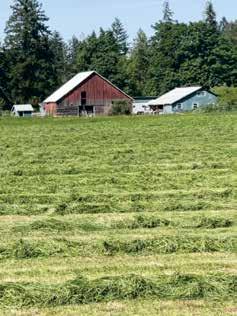
Scenic country roads dotted with century-old farms, homesteads, farm-gates and artisan studios are only a glimpse of what the Cedar District has to offer. Located north of Ladysmith, Cedar Village is the commercial centre, with a grocery store, hardware, fuel station and some of Vancouver Island’s best restaurants and pubs. Farm co-ops, organic growers and markets provide fresh produce to feed your body, but Cedar’s spectacular sandstone beaches and trails will feed your soul.
Cedar and Yellow Point Roads are best enjoyed by car or bike with frequent stops along the way. Don’t miss Blue Heron, Elliots Beach, Hemer or Robert’s Memorial. All of these are easy hikes and offer stunning views, especially at low tide. Cable Bay Trail is a great place to watch boats streaming through Dodd Narrows at slack tide.
The Yellow Point Farms offers a family friendly experience with their petting farm. Open from March to November, you can visit their Nigerian dwarf goats, babydoll sheep, kunekune pigs, and miniature donkeys. You can also visit their farm store full of in-season produce and their delicious blueberry leaf tea.
Fredrich’s Honey is a family-owned bee farm providing unpasteurized and wildflower-based Canadian honey. A visit to their farm is

Healing Project at Wildwood Ecoforest, Hay fields in Cedar, Quennell Lake. Black Diamond Video Games and Pinball Arcade. Photos: Marina Sacht Local produce. Photo: Carolyn Herriot
always a sweet delight! Keep in mind, they have moved to a new location at 2081 Lazy Susan Drive.
The Cedar Community Hall Association and North Oyster Community Centre host a variety of monthly events and community fairs.
Looking for some active fun? Drop by the Cedar Skate Park on Walsh Road and try out your moves.
Cedar shares a history of coal mining with Nanaimo and its neighbours: Ladysmith, Chase River, South Wellington and Cassidy. Echoes










of this history can be found in the Morden Colliery Historic Park, which is the location of the Morden Mine. Its tipple and headframe are one of the only two surviving examples of concrete headframes in the world.
The Extension Miners Community Park is worth the visit to explore the area’s mining past and view the restored Dunsmuir coal cart, along with other artifacts.
The area is also home to several pubs and restaurants with a long history of serving locals. The popular British Crow and Gate


Neighbourhood Pub was opened in 1972 and has the distinction of being the first neighbourhood pub in BC. The English gardens, Tudor-style architecture and tranquil rural setting attract locals and visitors alike. In the summer, relax on their outdoor patio, and in the winter, cosy up next to the roaring fire as you enjoy their excellent selection of beers.
The legacy of firsts continues today with COCO Cafe. Their mission is to provide jobs and opportunities for people with diversabilities as well as serve the Cedar community delicious food.
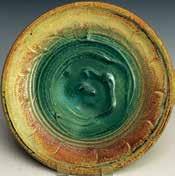






The award-winning Cedar Farmers’ Market is one of the most popular markets on the Island—and the numbers prove it. You’d better get there early, as about 59,291 people visit annually! The market operates Sundays, 10 a.m. to 2 p.m., from Mother’s Day to the end of October. The market features locally grown fruit and vegetables, baked goods, ethically raised meat, freshcut flowers, food trucks, homemade ice cream and more. Pets are welcome.
A number of farm-gates operate in the area, including McNab’s Farm, which has a variety of squash, corn, potatoes, and a book exchange.
Another popular market on Sundays is Carol’s Artisan Craft Market located at the North Oyster Community Centre. The regular artisans sell a variety of handmade knits, funky birdhouses, wooden bowls and beautiful pottery. It’s the perfect place to do your early holiday shopping.
Nestled along the shores of Quennell Lake, Wildwood Forest is 83-acres of lush ecoforest. It boasts a richness of wildlife from the little brown bats and banana slugs, to the towering coastal Douglas-firs. The forest represents a vanishing ecosystem that was once abundant on Vancouver Island. These ancient trees stand among a profusion of western red cedar, bigleaf maple, flowering dogwood and arbutus trees, and bring an amazing presence to the forest in their towering height and size. Established in 1938 by Merv Wilkinson, it is operated by the Ecoforestry Institute, which hosts vacation stays, workshops and tours.
On a warm summer day, the riverbanks hold popular spots for swimming, tubing and picnicking. You can launch your tubes

Award-wining Cedar Farmers Market opens from May to October. Photo: Nick Longo
by the bridge on Cedar Road. The beach is on the Snuneymuxw Reserve.
The area is known for its rock-climbing opportunities with the best locations on the Island for conglomerate sandstone bouldering. The river cuts through a large canyon, which is the site of Wildplay Adventures with a bungee jump attraction.
The Nanaimo Lakes are located on the upper Nanaimo River and have four unserviced campsites. The sites are right on the banks of the lakes with boat launches, beaches and hiking trails. The campsites are owned by Mosaic Forest Management.
The Nanaimo River is regarded by anglers as one of the best steelhead rivers in the country. Coho salmon fishing is open October to March.
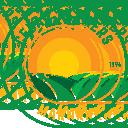
The Nanaimo River Hatchery is run by the non-profit Nanaimo River Stewardship Society. Annually, on the first Sunday in November, the hatchery hosts a public “Spawning Day.” The event is great for families, especially kids, as it highlights the miraculous life cycle of Pacific salmon.
The Nanaimo River Estuary supports a large number of plant life, fish and wildlife species and is the largest estuary on Vancouver Island. It is an important traditional use area for the Snuneymuxw First Nations. This short trail on the banks of the Nanaimo River has viewing platforms and is a popular spot for birding. Bring your binoculars and spot the eagles, great blue herons, red-tailed hawks, Canada geese, ducks, crows and owls.





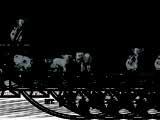



Picture a town colourful in history and alive with art. Throw in unique shops, tasty eateries and a world-class theatre, and you have Chemainus.
The town is unique in having two downtown sections. Willow Street runs through the centre of town, while Old Town is off Oak Street. This was the original downtown and still has an early boomtown feel about it. A ferry terminal connecting Thetis and Penelakut Islands is at the foot of Oak Street by the government wharf.
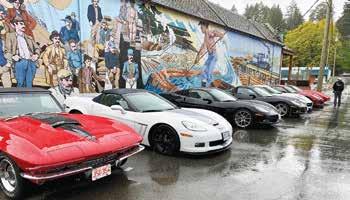

The town is completely walkable, with quiet streets and lots of places to stop and explore. Keep an eye out for the yellow footprints, which are always a favourite with kids.
Bargain hunters will find lots to rummage through at the Chemainus Thrift Store. Treasures await at several antique and specialty stores offering products, services and old-fashioned charm.
The town’s name comes from a legend about a shaman and prophet called Broken Chest (Tsa-meeun-is) who survived a chest wound and became a strong chief. His people loved him so much that they adopted his name and became known as Stz’uminus.
Founded as a logging town in 1858, Chemainus was once the heart of the early forestry industry and boasted the world’s largest mill. In the early settler days, the giant coastal forest of Vancouver Island offered unlimited logging. Chemainus, with its deep seaport, became the centre of this logging boom and operated for over 120 years.
When the mill closed in 1983, hundreds left town. Then, on the brink of being a ghost town, the mural project was born. The town







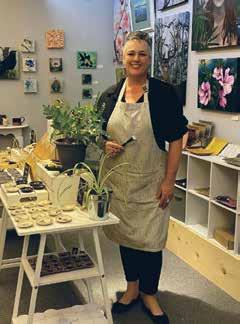
commissioned artists to paint its history in the largest mural painting project undertaken in Canada.
Today, Chemainus is a picture-perfect artisan village along the ocean. Thriving as a small-town tourist destination, those who visit are charmed by the local artistry that can be seen everywhere. Storefront windows hold handmade objects and gifts, the parks are lovingly adorned with carvings, and even the residential yards are dotted with topiary characters and creatures. It’s more than just a

pretty view for tourists, Chemainus is alive year-round with festivals and events that entertain locals and visitors alike.
Welcome to Canada’s Mural Capital! You will want to embark on a walking adventure and wander the streets and alleys to discover the over 60 murals and 10 sculptures that tell the story of Chemainus from its Indigenous roots to its pioneering settlement and








beyond. Organised by the Chemainus Festival of Murals Society, the mural project is the world’s leading community-driven art tourism experience. You can pick up an Official Mural Guide at several locations, including the Chemainus Visitor Centre and Museum and start your tour. Give yourself plenty of time to enjoy Canada’s largest outdoor art gallery and all the little shops along the way.
The Waterwheel Park is located in the heart of Chemainus and bridges the newer downtown area of Willow Street to Old Town with a short, forested footpath. A replica pays homage to the old water wheels once used to power the mill.
Chemainus Valley Cultural Arts Society hosts performances at the Waterwheel Band Shell throughout the year, including “Music in the Park” during the summer. The park is home to a playground for children, a meditation labyrinth, electric car chargers and a walking trail, which make


this a pleasurable spot to relax. There’s plenty of parking, and public washrooms, the Chemainus Museum, with its collection of artifacts and photos of the early days, and the Visitor Centre is also located there. This is also the location of a weekly market on Wednesdays, which runs from May to September. And don’t miss the annual Giant Street Market in July, when Willow Street is packed with approximately 150 vendors and food trucks.
As well as having a large arts community, Chemainus boasts a world-class performing arts centre. The Chemainus Theatre draws visitors from all over Vancouver Island. The theatre is also home to the Playbill Restaurant and a delightful store and gallery.
Outdoor enthusiasts will enjoy exploring the parks, trails and coastlines. There are several beaches to swim and picnic. Kin Beach is in Old Town and is easily accessible with a beach and a playground. At low tide, you can walk out to the lighthouse on


Bird Rock. Make sure to watch the tide and not get caught out there!
Boating is a popular activity here. The boat ramp at Kin Park is usually busy as residents and visitors explore the many small islands in the area. Off the shores of Chemainus is the world’s only sunken Boeing 737 diving reef, which draws divers from around the world. The reef is home to hundreds of local aquatic species, including the red sea urchin.
Just south of town is Fuller Lake, prized for its sandy beaches, warm water and good fishing. Tennis and pickleball courts, playgrounds and a boat ramp for non-motorized boats make this an enjoyable place to spend a day. In the winter, you can ice skate at Fuller Lake Arena.
Chemainus Lake Park, located west of town, is a great place for fishing off the dock or hiking the trail that encircles the lake.
Askew Creek Wilderness Park, at the corner of Oak Street and Chemainus Road, is a jewel and one of Chemainus’s best-kept secrets. Here you can wander amidst oldgrowth timber and imagine what life was like when trees were giants.


The community of Saltair is situated between Chemainus and Ladysmith and is known for its sweeping ocean views. Its location and the natural coastal beauty allow for a healthy lifestyle, with close access to many parks and recreation opportunities. A few shops and services are clustered around the tiny commercial centre on Chemainus Road, but the main shops and services are a short drive away in the neighbouring towns.
Gardening is a popular activity here, and not surprisingly, “Sunny Saltair” was once known as the “breadbasket” of the Island, supplying other areas with fresh fruits. Some heritage trees and multigenerationally operated farms can still be seen today.
Social life in Saltair centres around Centennial Park, a multi-sport community park, and the Saltair Community Centre, which is next to the park. Check their website for upcoming events.
Saltair’s name comes from the early days when the E&N Railroad stop was named Saltair Landing. While the trains are no longer running, walking the rails is one of Saltair’s pleasures, and the Saltair Rail with Trail is a 4.3-kilometre multi-user stretch of the Trans Canada Trail used by walkers and cyclers.
Davis Lagoon and its bridge is where Stocking Creek meets the ocean. This is a popular spot to observe the self-dumping log barges. Often, you will see cars pulled over by the Lagoon Bridge, watching the barge tip on its side until thousands of logs slide into the ocean with a roar and a mighty splash. The spot is also teeming with wildlife and a great place to kayak.


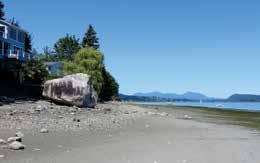



Stocking Creek Park is Saltair’s jewel, offering many kilometres of trails through a rainforest. The trail starts at the parking lot off Thicke Road, where restrooms are available. The short loop meanders through a lush forest with large moss-covered trees and ferns. The highlight is Stocking Creek Falls. The trail is open all year, but the best time to see the full beauty of a Vancouver Island rainforest is January through October.
Boulder Point, also known as Big Rock Beach, is a particular favourite among children. Visit this beach at low tide, when you can walk along the shore, beach comb and admire the sand dollars. Plenty of interesting finds exist, like weathered oyster shells or unique bits of driftwood. Watch for otters or seals swimming in the water or even a great blue heron fishing in shallow water. The beach is a great place to swim and picnic. Pets must be on a leash.















“Everyone deserves a home that adapts to their needs and supports their health and well-being.”

A Perfect Place to Build Your Dream Home
Nestled between breathtaking coastlines and rugged mountains, Ladysmith offers the perfect mix of small-town charm and modern convenience, with easy access to larger cities. It’s no surprise that more people are choosing to make this beautiful town their home. When you settle in Ladysmith, ensuring your home suits your longterm needs is essential—and that’s where GNB Builders come in.
With a mission to create high-quality, custom homes that adapt to their owners’ needs, GNB Builders has become a cornerstone of the Ladysmith community. Celebrating 21 years of building excellence and dedication to the area, GNB Builders has earned 18 awards across categories such as Best Builder, Best Home, and Best Kitchen. Additionally, GNB Builders has been Built Green certified for 18 years, showcasing their commitment to environmentally friendly construction practices.
Craftsmanship and Design Expertise
Led by Greg Bianchini, a Journeyman carpenter with 38 years of industry experience, GNB Builders combines skill, innovation, and passion. Together with his wife, Heidi Bianchini—the company’s manager and designer—they’ve built a reputation for creating exceptional custom homes.
Greg also offers in-house building plans and design services, drawing on over 18 years of experience designing custom homes, shops, and carriage houses. “By assessing a property’s strengths and challenges before a purchase, I ensure the best start to the project by designing a home that fits the client’s budget,” Greg explains.
Turning Dreams into Reality
As the company’s in-house designer, Heidi works closely with clients to bring their visions to life. “It’s about spending time with the client and building a trusting relationship,” she says. “Getting that little excitement and sparkle is really important.”
Heidi’s expertise goes beyond selecting finishes—she focuses on creating homes tailored to each client’s lifestyle and aspirations. “Even though the homes we build are custom, we always advise on features like resale value, aging in place, and secondary suite potential,” she adds.
The Canada Secondary Suite Loan Program makes it easier than ever to create laneway homes and carriage houses. With Ladysmith now allowing laneway homes in certain zoning areas, homeowners have exciting opportunities to add value and flexibility to their properties.
GNB Builders has seen a growing demand for homes with secondary suites, especially in a town where housing options for older residents can be limited. “Many homes we build include suites designed for aging parents or young adults starting out,” Heidi says. These thoughtfully designed spaces provide independence while keeping families close.

As certified Adaptive Home Renovators, GNB Builders designs homes that help individuals stay in place longer. Adaptive Home Renovations cater to those recovering from injuries, managing health conditions, or adapting to physical changes.
“Everyone deserves a home that adapts to their needs and sup-

ports their health and well-being,” Heidi emphasizes. GNB Builders proudly offers this transformative service, with rebates available to make these essential modifications more affordable.
Investing in the Trades
GNB Builders is also committed to mentoring the next generation of builders. Through apprenticeship opportunities for Red Seal Carpentry students, the company combines hands-on training with education. “We’re looking to add a Ladysmith student to our team,” Greg shares, highlighting their focus on developing local talent. Apprentices earn money, gain school credits, and build the foundation for a rewarding career while working alongside experienced professionals.
Whether you’re envisioning a custom home, planning a renovation, or considering an addition, GNB Builders is here to bring your vision to life. With decades of experience, a commitment to sustainable building, and a focus on creating homes for life, GNB Builders is a trusted name in Ladysmith and beyond.
- Francesca Pacchiano/TAKE 5 in collaboration with GNB Builders.









You’ve come to the right area for outdoor fun! With close proximity to four golf courses, you’re minutes away from swinging your personal best. Opened in 1948, the par 71/73 Mount Brenton Golf Course has shaded fairways flanked by towering firs, with willow, hemlock, maple, scotch and ponderosa pine, sequoia, cedar, dogwood and giant cottonwood. A challenge for every level of golfer, there are plenty of creeks to hurdle and ponds to circumvent. An extensive drainage system also makes Mount Brenton one of the most playable golf courses year-round on Vancouver Island.
Ladysmith Golf Club was opened in June 1980. It is owned by the Town of Ladysmith and is operated and managed by the non-profit Ladysmith Golf Club Society. Everyone from the age of six and up is welcome to enjoy this nine-hole par 3 course. It takes approximately one hour to play but is challenging with two ravines to drive over and large, tricky greens. This course will test your short iron game and your putting skills.
Looking for an adrenaline rush? Nanaimo’s WildPlay Elements Park, north of Ladysmith, offers ziplines, bungy jumping and an ob-
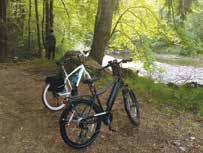
stacle course in the tree canopy. It’s the ultimate place to face your fears.
There are many parks and walking trails from a leisurely seashore stroll to a heart-pounding hike to Heart Lake. The steep climb has been known locally as “Heart-Attack Lake,” but offers a switch back for a more civilized route.
Enjoy some of the best walking, hiking and biking trails the Island has to offer. Here’s some of our favourites.
Holland Creek Trail is unique for its views of Crystal Falls. Approximately 5.8-kilometres long, the trail has connectors at either end if you wish to make the walk more challenging. The trail is suitable for different fitness levels from the well-groomed path, with some sections that are wheelchair accessible on the north side of the creek. The creek exits into a flat grassy lowland by the ocean, creating an estuary that provides habitat for birds in a small delta.
Branching out from the Holland Creek Trail are several other trails. Rotary Lookout Trail is a short 1.2-kilometre walk, which is accessed close to the log bridge on the Holland Creek Trail.


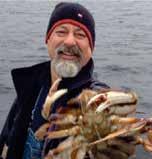
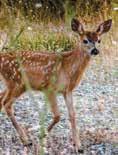
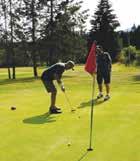

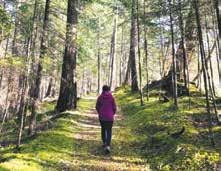



Heart Lake Loop Trail is a challenging 6.4-kilometre hike but rewards you with a panoramic view of the ocean and islands. Stocking Lake Loop is a 9.3-kilometre trail that begins at Davis Road Park and takes 2.5 to three hours to complete.
Marine Walk can be accessed from the Ladysmith Fisherman’s Wharf, Oyster Bay Marina or by the parking lot at the amphitheatre. It crosses Slack Point, which gets its distinctive black colour from the remnants of loading coal at the turn of the century. The section between Fisherman’s Wharf and the Oyster Bay Marina follows an old railway track used to bring in coal from Extension Mines.
Gourlay-Janes Park, off Chemainus Road, is an off-leash park where you can walk through the woods to the ocean.
Diana, Princess of Wales Park, between Olsen Road and Rocky Beach Road, has a pleasant and very easy level walking trail that leads you through beautiful natural landscapes.
Stocking Creek Park, with the south entrance off Thicke Road (from Chemainus Road) and the north entrance off Finch Place, has natural trails, picnicking and a waterfall. The Cowichan Valley Trail, a multi-use trail that is an integral part of the Trans Canada Trail route on Southern Vancouver Island, also runs through the park, offering a connection south to Chemainus and north to the Town of Ladysmith. Finch Place offers access to the Cowichan Valley Trail.
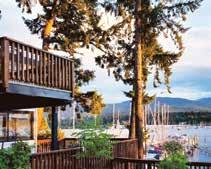

Saltair Centennial Park is located on South Oyster School Road. Saltair Rail with Trail starts at North Watts Road and goes to Chemainus. The 4.3-kilometre trail opened in 2019, connecting the communities of Ladysmith, Saltair and Chemainus with a threemetre-wide compacted gravel surface that is gently graded and suitable for walking and cycling. It is a popular trail for dog walkers. The trail includes a single-span bridge crossing Stocking Creek and scenic views of Mount Brenton and the Gulf Islands. Side trips into Stocking Creek Park and its waterfall are readily accessible from here.
Askey Creek Wilderness Trail, accessible from Oak Street, is an easy-to-follow trail system that the whole family can enjoy. It features numerous old-growth trees and a creek.
Bannon Creek Falls can be found if you hike in off Grace Road for a short but steep trail that takes you to the gorgeous waterfall.
Caswell Park is a residential green space and playground.
Chemainus Lake Park offers a 2.5-kilometre loop with multiple trails. The lake is a popular spot for fishing, birdwatching or letting your dog off-leash.
Chemainus River Provincial Park is a 128-hectare park that offers swimming and recreation opportunities. It is also a popular spot for anglers.





Chemainus Skate Park is located next to Chemainus Secondary School and offers 2,500 square feet of fun for BMX bikes, scooters, in-line skaters and skateboarders
Cook Beach Park, with access through Island View Close, is a peaceful spot to watch the ocean and picnic.
Daniel Street Park offers a small green space with access to the waterfront, but come at low tide to enjoy the beach.
Doc Lewis Park has a large ballfield with four pitches.
Fuller Lake is a very popular swimming spot with a lifeguard during the summer. It also has a boat ramp for boats with electric motors, canoes and kayaks. There is a fishing pier, and the lake is stocked regularly with cutthroat and rainbow trout.
Fuller Lake Arena offers a 200-foot by 85foot ice surface.
Gerry Smith Park has landscaped gardens, with a steam train on display.
Kinsmen Beach Park has a sandy beach with warm, shallow waters for swimming and beaches to picnic and take in the views while the children enjoy the playground. There is a small boat launch.
Waterwheel Park is centrally located downtown. This small park offers a play-







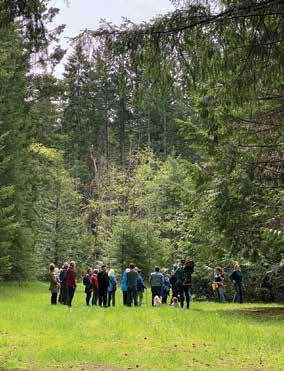
ground, washroom and a widely-used outdoor stage, which is a venue for many performers.
Wul’aam (Echo) Park is a rugged trail network at the end of Channel Boulevard. It loops through firs, cedars and maple trees.
Blue Heron Park is on Westby Road, off Yellow Point Road. It has a beautiful sandstone beach, restrooms and a picnic area.
Cable Bay Nature Trail is a favourite spot to watch marine traffic navigate the narrows. This is an off-leash trail.
Elliots Beach Park on Elliot Way, off Shell Beach Road, offers picnicking, swimming, snorkelling and kayaking.
Extension Ridge Trail is part of the Trans-Canada Trail system. It offers stunning views of the Georgia Straight. The 8.9-kilometre loop trail features a great forest setting and is an excellent spot for both hiking and mountain biking.
The Abyss Trail, an Extension Ridge attraction, is a fissure in the earth. Known to locals as “the Abyss,” this 4.5-kilometre section is a playground for mountain bikers, hikers and dog walkers. The switchbacks are steep and moderately challenging.
Haslam Creek Trail and Suspension Bridge is part of the TransCanada Trail system. Access is at the end of Timberlands Road.
Hemer Provincial Park has easy walking trails. Mainly forested, it’s a peaceful setting for walkers, paddlers, boaters and anglers. A bird-watching platform is available.
Morden Colliery Regional Trail offers walkers a chance to follow parts of the coal railway route that once linked the mines of South Wellington to the coal ships docked at Boat Harbour. The trail connects Morden Colliery Historic Provincial Park with Hemer Provincial Park and runs along an old rail grade that was used to move coal during the early 20th Century. To see the historic Morden Tipple and headframe, take a short walk to the Nanaimo River or head to Hemer Park from the Cedar Plaza kiosk.
Raven Park on Shell Beach Road is a small but pretty beach park.



Roberts Memorial Park leads to the waterfront and has areas for picnicking, fishing, biking and hiking. It is known for its unique sandstone ledges and wildlife watching, including sea lions.
Yellow Point Park features trails dotted with wildflowers in springtime. The 5.3 km loop is good for all skill levels and is primarily used for hiking, nature trips and bird watching.
A myriad of outdoor recreation opportunities lie north of Ladysmith. Visit the Bush Creek Hatchery, operated by Ladysmith Sportsmen Club members. Members are usually there on Saturdays from 9 a.m. to noon. Beyond the hatchery is the trailhead for Christie Falls. It’s about 2.5 kilometres from the gate to the tiered fall and is a must-see.
Timberland and Cassidy offer back roads that access several lakes for outdoor wilderness adventure. So, grab your hiking boots and explore nature’s playground.


By J. PERSSON
Vancouver Island’s waters are home to some of the most unique and interesting sea creatures on Earth.
Here are some of the critters you can find in our local waters.
Sea Snails Have you ever found a rubber-like collar in the ocean? You might be surprised to find that this isn’t discarded plastic garbage, but instead the egg casing of a moon snail.
These snails burrow under the sand and excrete a mucus that sticks to the sand, forming a ring around their shells where they then lay eggs. These casings stay buried in the sand, camouflaged by their sandy exterior.
Starfish Ocher starfish come in a variety of colours, from pink, purple, brown, orange and yellow. Recently the population of starfish has fallen rapidly due to a disease, but their numbers are slowly recovering. Ocher starfish have been known to live up to 20 years and can grow about 20 centimetres in length!
Barnacles Barnacles aren’t just spiky growths; they serve an important purpose in the ocean’s ecosystem by filtering the water and feeding on the micro-organisms inside. Even the simplest of sea creatures can serve an important role. Did you know that barnacles are closely related to crabs and lobsters as well?
Sculpin Tidepool sculpin are small spiny fish that often like to hide in tidal pools. You’ve likely caught a few if you’ve spent some time at the beach. These fish will try to eat nearly anything, making them a particularly easy catch. You may know these fish as bull-
Elliots Beach Park, a popular spot for snorkelling. Photo: Marina Sacht

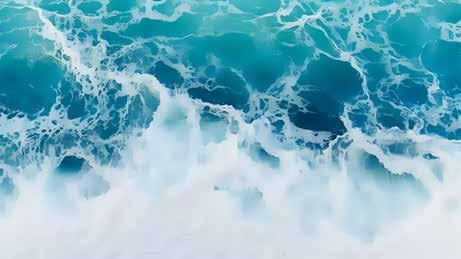





head, which is a very similar fish species often found in rivers and lakes. The two fish are mistaken for their similar appearance and attitude.
Jellyfish Jellyfish come in many different varieties, but two are the most common. First is the moon jellyfish, which come in a see-through or misty white colour variation. These jellyfish are mostly harmless; their stings being incredibly tiny and almost unnoticeable to humans.
The red jellyfish, also known as the lion’s mane jellyfish, vary in species across our coastlines. These are NOT safe to touch! They can cause immense pain and leave lasting issues, such as infection. If you see a red jellyfish, observe it from a healthy distance.
Octopus Why do we find octopuses so fascinating? Octopuses show lots of interesting features: they have a funnel for jet propulsion, adaptive skin for camouflage, an ink sack to fend off predators, three hearts and pulsating veins, big eyes that are very similar to our human eyes, an elaborate brain and prehensile arms with a mind of their own.
A large boating community is centred around the four marinas in Ladysmith Harbour. Additionally, there is the Boat Harbour Marina in Cedar and the Government Wharf in Chemainus. Visitor moorage can be found at the government wharves. Ladysmith Yacht Club offers reciprocal moorage. Boat launch ramps are available at Ladysmith Fisherman’s Wharf, Cedar by the Sea and Chemainus Kin Beach Park. There is a fuel dock in Chemainus and Thetis Island. The volunteer-operated RCM-SAR serves the local boating community.
The Ladysmith Dragon Boat Society is a thriving part of the local community, with boats on the water regularly during the

week. They have three teams that race, promote health and are recreational. Additionally, they host spring and winter courses with drop-in options when space is available.
The Stz’uminus First Nations are well known for their war canoes. The vessels are hand-carved and made of cedar, holding a crew of eleven. This tradition is kept alive today with annual races held at Kulleet Bay in July. Crews also participate in the War Canoe Races, hosted by WSÁNEĆ Leadership Council, from May to August, with locations across Vancouver Island and the lower mainland.
The Ladysmith Maritime Society promotes maritime education and heritage tourism in the area. Its heritage boat restoration program has earned it worldwide
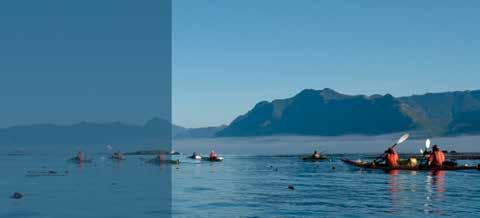
recognition. The society is located in the former Comox Logging & Rail Co.’s “Car Shop” along the waterfront. Stop by and watch it bring back to life wooden boats from a time when beauty and craftsmanship were king. It’s heritage fleet is moored at Thetis Island Marina. For information on its programs and services visit www.lmsmarina.ca.
If you enjoy kayaking or paddleboarding, you will love it here. Large tracts of shoreline and small islands are within easy reach. Ladysmith’s Transfer Beach Park offers the perfect launch site or stopover. Bute Island, just across the harbour, is a marine park with a community dock, a walking trail and several spots for excellent swimming. Beyond the inner harbour, Evening Cove and Elliots Beach Park offer a reprieve from the more open waters of Stuart Channel. Saltair has an expansive beachline, and Chemainus offers oceans and lakes to discover.
Bring your binoculars and watch for harbour seals, sea lions, otters, sea stars and sea anemones. You might even see a great blue heron or two.
You can explore further with day trips to the surrounding islands.
Catch the ferry at Crofton to Salt Spring Island. The island is a year-round visitor destination with creative workshops, wellness programs, and live entertainment. Oceanside pubs, restaurants, and locally produced wine, cider, and cheese are an enticing draw for many. If you go in the summer, check out the vibrant Saturday Market.
The ferry to Thetis Island leaves from Old Town in Chemainus. This little island is quieter, with rural farm stands and quiet beaches. It’s the perfect place to relax, and it has beautiful beaches.




















This area is home to many performers, artisans and internationally acclaimed artists, including musicians David Gogo, Ryan McMahon and Nate Harris, artists, carvers and talented crafters. Live music is appreciated here with small venues to outdoor summer festivals hosting local and international performers.
Visit Cedar and Yellow Point’s artists, crafters and farmers by taking family and friends on a relaxing self-guided Country Christmas Tour held annually in November. During the summer, artisans keep their own hours. For more information, visit www.cyartisans.com.
The Chemainus Valley Cultural Arts Society is an active group that hosts and promotes several musical events, including an open mic year-round. Rainforest Arts features local artists’ work and operates under the CVCAS umbrella. The Chemainus Sketch Group has a long history and a large membership.
The Ladysmith Arts Council operates a gallery on the corner of High Street and First Avenue. The group offers workshops and organizes events such as Arts on the Avenue, a street festival in August.
Ladysmith Little Theatre offers great entertainment. They are in a converted schoolhouse built in 1912. Along with their play season, they offer workshops and participation in an improv group. For
(left to right)
JoVic Pottery & Art, Photo: Josee Duffhues, Kirkegaard in Ladysmith Harbour.
Photo: Bob Burgess
Arts on the Avenue “Art Jam”. Photo: Sophie Paisley, Restored Loci #11 engine, Live music at Ladysmith Forest Festival.
Photo: Marina Sacht
Stz’uminus Ceremony at Indigenous Peoples Day, Transfer Beach.
Photo: Bob Burgess
more information, visit www.ladysmiththeatre.com. New on the scene is the Ladysmith Musical Arts.
The Yellow Point Drama Group is the second oldest drama group in the province. Formed in 1953, the group has won numerous awards and performs at the historic Cedar Community Hall.
The Chemainus Theatre Festival offers professional plays, a summer program, a restaurant, a gallery and a gift shop. They are an economic driver for Chemainus, proving the business value of art. The non-profit society offers uplifting performances and is known for its musicals.
The Mid-Island has an eons-long history of Coast Salish people, whose way of life centred around the coast and forests with their abundant natural resources. The area was settled by Europeans seeking new opportunities afforded by black gold (coal) and tall timbers. Relics of the past are still evident, especially along the







waterfront. The forestry industry remains important, although the economic base has broadened.
While this area has enjoyed considerable growth, it has retained its small-town charm and community warmth.
Take a stroll along award-winning First Avenue in Ladysmith and enjoy what the stores and restaurants offer and the heritage buildings they are located in. As you walk downtown, look at the industrial artifacts on display. Refer to the online Community Heritage Register and the Heritage App for individual histories.
Visit the Ladysmith Museum and Archives for more information on the community and its formation. The museum’s featured exhibit for 2025 will be The Beat Goes On: Ladysmith’s Music and History.
Head down to the harbour and visit Transfer Beach Park, once the centre of a coal port with extensive wharves, shrieking steam engines and clattering coal. Today, it is a haven of tranquillity, with beautiful vistas, a playground and an open-air amphitheatre. Stroll the paths along Oyster Bay Drive and visit the Ladysmith Maritime Society’s Boat restoration shed, where volunteers are restoring beautiful heritage boats. The building is known as the Car Shop and is part of the group of buildings that were a part of the Comox Log-


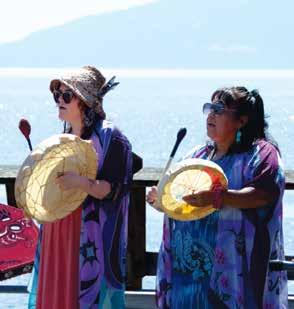
ging & Rail Co. Depot. You can still see remains of the industrial artifacts here, including its railway tracks, outer buildings and the beautiful Baldwin steam locomotive that is over 100 years old.
A stroll through Chemainus offers a different experience. Here, the story of the original murals brings the town’s history to life. The original downtown is Old Town, where the commercial heart of the town was located. Waterwheel Park is the heart of the community. This area was once part of the grounds of the mill manager’s house, located by the statue of HR MacMillan.



The present Waterwheel is a replica of the original that powered the early mills. This wheel and the park’s first phase were constructed as part of the 1967 Canadian Centennial celebrations.
The park has a bandstand where concerts take place in the summer. Adjacent to the park is the Public Washrooms and the Chemainus Museum and Visitor Centre. Operated by the Chemainus Valley Historical Society, the museum is a wonderful place to learn about the area’s history. Outside, you will find a view of the Gulf Islands and the busy harbour. This is the site of the first and present sawmill.
There were a large number of mines working in the Mid-Island area starting in 1897. A must-visit is the Morden Colliery Historic Park, the location of the Morden Mine. Its tipple and headframe are one of only two surviving examples of concrete headframes in the world. Take time to walk the trails here. The interpretive signs help to bring to life the ruins of the buildings. A miners’ memorial is located there. Picnic tables and a walk to the Nanaimo River is a pleasant way to spend a few hours.
The Coast Salish Peoples encompass many First Nations with land stretching from Vancouver Island to BC’s mainland coast and into the United States. The area from south Nanaimo to Chemainus is home to several First Nations people.
The Snuneymuxw First Nation, Stz’uminus First Nation, Lyackson Mustimuhw, Penelakut Tribe, and Halalt First Nation have called Vancouver Island, its surrounding islands and even pieces of the lower mainland home for thousands of years. They speak a common Coast Salish language, Hul’q’umi’num, and share cultural values such as storytelling, music and the respectful use of the natural world.
The Stz’uminus First Nation had villages at Thuq’min (Shell Beach) and at nearby Q’ul’its’ (Kulleet Bay), where they would fish and dig for clams. The people paddled dugout canoes across the Salish Sea to visit relatives and fish the salmon runs on the Fraser River.
Music is an important part of Stz’uminus culture. Singing and chanting is accompanied by hand drumming on a deer hide drum. The songs reflect the natural and
spiritual worlds, celebrate life events and connections to their way of life. Some such as the canoe songs were a way to introduce travellers as they entered the territories of other First Nations. It was a sign of peace and friendship, not war.
Songs in Hul’quimi’num continue to be composed today, including the Stz’uminus National Anthem, which was written by Elder George Harris.
Traditionally, travel by sea was only possible with dugout canoes. Carved from old growth cedar trees, these canoes could transport more than 50 people and were used to cross the channel to the mainland and parts of northwest America. Master carvers Manny and Elmer Sampson carved a red cedar canoe that can be seen at Transfer Beach. The canoe was commissioned as part of the Canada 150 celebrations in 2017. Located on the historic site of a First Nations fishing village, the canoe is significant in representing the history of the Stz’uminus people and the land.
A Dark History
When European colonists came to Canada, they moved to assimilate Indigenous Peoples with settler society through the forcible removal of children from their communities. The children of the Stz’uminus First Nation, some as young as four years old, were taken to various residential schools, the nearest on Penelakut Island (then called Kuper Island). The Kuper Island Residential School was in operation from 1889 until 1975. The school building was demolished in the 1980s in an effort to expunge painful memories.
Today, Penelakut Island is closed to visitors without invitation. The Penelakut Tribe has a vibrant local economy, with the traditional language and cultural customs being celebrated and practised.



Red Dress Day, on May 5th, is a day to raise awareness for the missing and murdered Indigenous women and girls (MMIWG), and to encourage learning and action to end it. Red dresses are hung on the trees along the Trans-Canada Highway ahead of May 5th and can be seen throughout the communities.
Indigenous Peoples’ Day
June 21st has been a day of celebration for generations of many Indigenous Peoples because of the significance of the summer solstice as the longest day of the year. The day was first marked in 1996 by the federal government as a day of celebration of the heritage and cultures of First Nations in Canada.
Local Stz’uminus celebrations are marked by an opening Hul’q’umi’num prayer, singing, dancing and other cultural events. The event is held at Transfer Beach.
Truth and Reconciliation
Orange Shirt Day, September 30th, is a statutory holiday to honour the Survivors of Canadian residential school institutions and those who never made it home. It’s a day to pause and reflect on the intergenerational impacts of the residential schools.
The Orange Shirt Day is an Indigenous-led grassroots organization that raises awareness of the impacts of residential schools and promotes the belief that “Every Child Matters.”
Speaking from Experience
Raymond Tony Charlie is a member and Elder of the Penelakut Tribe. As a child, he attended two residential schools, one of which was the Kuper Island Residential School. Six decades after enduring abuses at the school, Charlie wrote about his experience in his memoir In the Shadow of the Red Brick Building. The book outlines his experience, his family’s experience and how the residential school continues to impact them decades and generations later.

The book is available for purchase at the Ladysmith Museum. Ye’yumnuts
Ye’yumnuts is a sacred ancestral place of the Quw’utsun people. Located in a residential neighbourhood in the city of Duncan on unceded Cowichan territory, Ye’yumnuts and its significance are unknown to many. The area has been an ancestral burial place for thousands of years. Commemorating Ye’yumnuts is a project to educate teachers, youth and the general public about the significance of this land.
Ye’yumnuts is open to the public and follows the banks of the Somenos Creek. The land is provincially protected as a Garry Oak preserve, with conservation efforts for both the Garry Oak trees and other endangered plants. For more information visit yeyumnuts.ca/ - Francesca Pacchiano




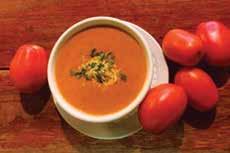

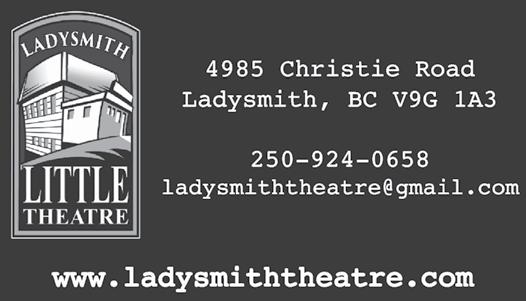






































BC Family Day Watch for events around the community. Heritage Week on the third week of February, features events at Ladysmith Museum and the Ladysmith Maritime Society.
Ladysmith SailPast is sponsored by the Ladysmith Yacht Club. Watch the floating boat parade and activities at Transfer Beach Park.
Cedar Farmers Market starts Mother’s Day and closes end of October. Every Sunday at Woodbank School in Cedar.
Transfer Beach Park Food Truck Concession runs until September. Annual Garden Tour. Fundraiser by Ladysmith Rotary.
Pride Celebration hosted by Ladysmith Pride Society.
National Indigenous Peoples Day This event celebrates the cultures and contributions of the First Nations, Inuit and Métis Indigenous peoples in Canada.
Canada Day events throughout the communities.
Concerts in the Park series starts in July and goes until end of August on Sundays at 6pm at Transfer Beach Amphitheatre.
Chemainus Giant Street Market Chemainus and District Chamber of Commerce annual Market features over 150 unique vendors lining Willow Street. Crafts, antiques, collectables, clothing, jewelry, skincare products, food, and so much more!
Brits on the Beach car show at Transfer Beach Park.
Chemainus Valley Cultural Arts Festival live music events and festivals kick off July and August. For details visit cvcas.ca/ Stz’uminus Canoe Races are an annual event at Kulleet Bay.
Ladysmith Days on BC Day Weekend offers fun for everyone. Live music and entertainment, vendors, food trucks, wraps up with fireworks at Transfer Beach.
2025 Cowichan Craft Beer & Food Fest Doc Lewis Park, craftbeerandfoodfest.com/
Ladysmith’s Pride Celebration’s block party. Photo: Bob Burgess

Chemainus Valley Cultural Arts Festival live music events and festivals continue in August. For details visit cvcas.ca/
Ladysmith Show and Shine First Avenue in downtown Ladysmith is lined with hundreds of makes and models of classic and treasured cars and motorcycles. Rod Run the day prior.
Arts on the Avenue Downtown Ladysmith street festival of art, entertainment and fun.
Oktobertfest Beer food and fun. ladysmithdowntown.ca
Fall Festival in Chemainus Waterwheel Park.
Sip & Shop Chemainus Ladysmith Festival of Lights starts Thursday of November and goes until mid January.
Country Christmas Artisan Tour cyartisans.com
Old Time Christmas. Ladysmith turns back the clock to celebrate Old Time Christmas events, downtown Ladysmith.
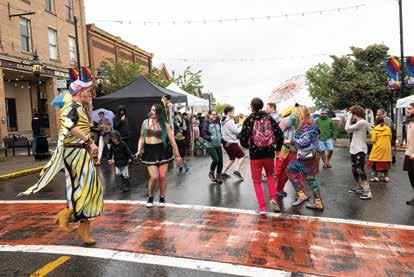
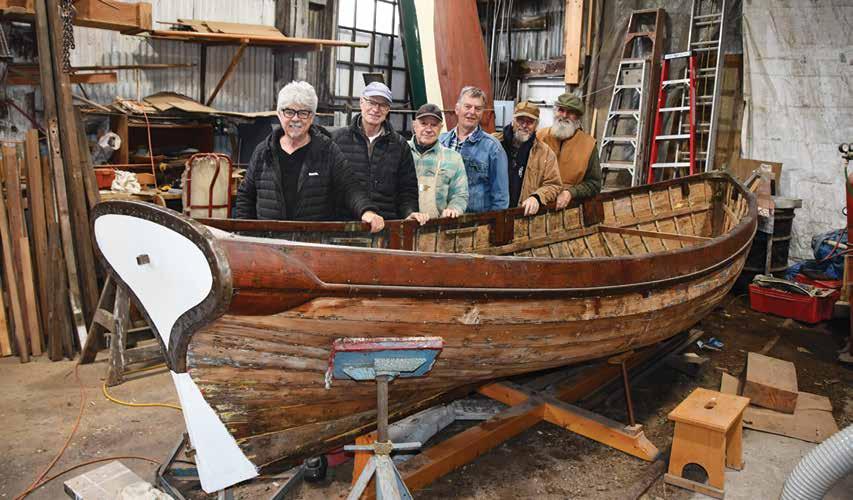
























Vancouver Island’s mild climate makes it an attractive home for numerous species of birds all year long. The central island is no exception. Whether you’re out for a stroll in the summer or watching a bird feeder from your window in the winter, there are always birds to be seen.
The abundance of food that thrives in the warm weather is what draws thousands of birds to this island. “It’s always about food,” Colin Bartlett, owner of the Backyard Wildbird and Nature Store in Nanaimo, said. He noted that the red flowering currant, ocean spray and Oregon grape — alongside insect hatchings and the herring spawn — all provide sustenance for the earliest arrivals each year.

It’s hotly contested as to which season is the best for bird-watching, with mass migrations in both the spring and fall, but truthfully, it’s less about the season and more about where you look.
The guaranteed places to spot our flying friends are the open areas that are lush with vegetation. Marshlands, fields, the edges of woods, parks, and estuaries are natural habitats, and open areas allow you to easily spot birds with a pair of binoculars.
Birders have had a lot of success at the local estuaries, including Nanaimo River Estuary, Buttertubs Marsh, Yellow Point Park, Transfer Beach in Ladysmith, Stocking Creek in Saltair, Hemer Park, Cable Bay Trail, Chemainus River Estuary, and the Somenos Marsh in Duncan.
Seasoned birding tips include the following: Do not wear bright colours, as they stand out against the vegetation. Keep your voice down, as birds are curious but easily startled. And don’t rush; take your time and enjoy the beautiful environment. Chances are, you’ll see more than just a bird or two. Additionally, make sure you’ve got a comfy pair of shoes since many of these areas have trails to explore.
The American Robin (skw’qeqe’) is one of the first birds in the spring. Look for the Brant Goose (xulxulc) on the coast. California Quail (kwil) are often trailed by chicks. The Kingfisher (tth’uchulu) likes waterways and the Red-winged Blackbird (çqwaqwa) is found in marshlands.
In summer, keep your eyes open for the bright zip of Anna’s Hummingbird (sxwutculi). Marsh Wrens (tutúm) are found in marshes. The Common Raven (spaal’) is everywhere. Look for the large nests of the Osprey (tth’ihwtth’uhw). At the ocean, catch a Great Blue Heron (smuqwa’) while he’s fishing.
In Autumn, listen for the squawk of the Steller’s Jay (skwitth’uts). Trumpeter Swans (s-hwuw’qun) return to glide across lakes. Canada geese (‘exu) honk loudly as they fly. Mallard Ducks (tunuqsun) gather in flocks on ponds. The Northern Flicker (tth’iqt) can be spotted in open fields.
In winter, Violet-green Swallow (qw’uqw’sutsun’) can be seen flying in a swoop. The beaches and coastal cities are home to many California Gulls (qwuni). Bald Eagles (yuxwule’) nest in old growth trees. The Spotted Towhee (sxesh) enjoys brushlands. The Rufous Hummingbird (sxwut’ts’uli) brings a spot of colour to the winter months. - Francesca Pacchiano and Kerith Waddington









